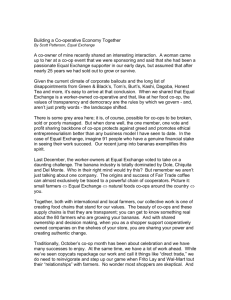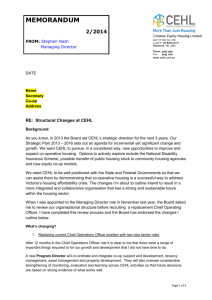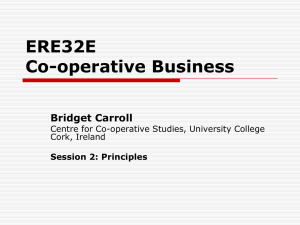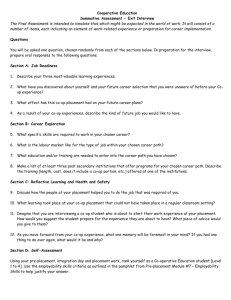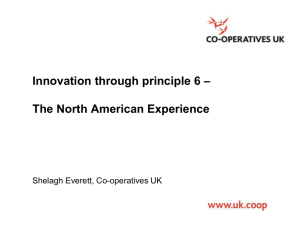AEC-58 - UK College of Agriculture
advertisement
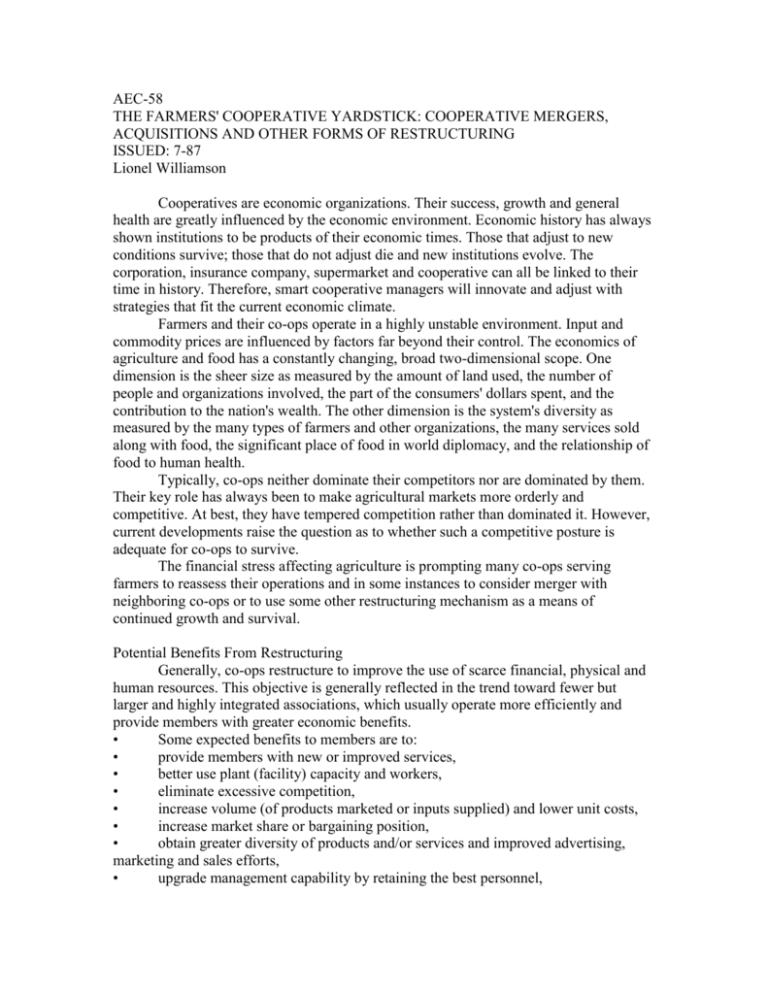
AEC-58 THE FARMERS' COOPERATIVE YARDSTICK: COOPERATIVE MERGERS, ACQUISITIONS AND OTHER FORMS OF RESTRUCTURING ISSUED: 7-87 Lionel Williamson Cooperatives are economic organizations. Their success, growth and general health are greatly influenced by the economic environment. Economic history has always shown institutions to be products of their economic times. Those that adjust to new conditions survive; those that do not adjust die and new institutions evolve. The corporation, insurance company, supermarket and cooperative can all be linked to their time in history. Therefore, smart cooperative managers will innovate and adjust with strategies that fit the current economic climate. Farmers and their co-ops operate in a highly unstable environment. Input and commodity prices are influenced by factors far beyond their control. The economics of agriculture and food has a constantly changing, broad two-dimensional scope. One dimension is the sheer size as measured by the amount of land used, the number of people and organizations involved, the part of the consumers' dollars spent, and the contribution to the nation's wealth. The other dimension is the system's diversity as measured by the many types of farmers and other organizations, the many services sold along with food, the significant place of food in world diplomacy, and the relationship of food to human health. Typically, co-ops neither dominate their competitors nor are dominated by them. Their key role has always been to make agricultural markets more orderly and competitive. At best, they have tempered competition rather than dominated it. However, current developments raise the question as to whether such a competitive posture is adequate for co-ops to survive. The financial stress affecting agriculture is prompting many co-ops serving farmers to reassess their operations and in some instances to consider merger with neighboring co-ops or to use some other restructuring mechanism as a means of continued growth and survival. Potential Benefits From Restructuring Generally, co-ops restructure to improve the use of scarce financial, physical and human resources. This objective is generally reflected in the trend toward fewer but larger and highly integrated associations, which usually operate more efficiently and provide members with greater economic benefits. • Some expected benefits to members are to: • provide members with new or improved services, • better use plant (facility) capacity and workers, • eliminate excessive competition, • increase volume (of products marketed or inputs supplied) and lower unit costs, • increase market share or bargaining position, • obtain greater diversity of products and/or services and improved advertising, marketing and sales efforts, • upgrade management capability by retaining the best personnel, • obtain greater access to sources of financing and supplies and on more favorable terms. Potential Limitations From Restructuring Some limitations from restructuring may include: • higher costs to the co-op during initial stages of restructuring, • personnel problems and conflicts that arise with lowered morale, • difficulty in replacing loyalty to former co-op with loyalty to the restructured coop. Loss of local pride, • lower cost economics than projected, • strain on management due to increased management problems, dismantling of plants and replanning of all operations, • too long a time needed to complete the restructuring process, • certain member interests compromised, • lack of identification with "new" leaders of restructured cooperative, • greater chances of stricter regulation by local, state and federal authorities. Restructuring Through Mergers, Acquisitions and Consolidations In co-op mergers a stronger co-op generally takes over a weaker one. During a merger the surviving co-op maintains its identity and many of its organizational features. Co-op acquisition involves the outright purchase of all or part of one co-op's assets by another co-op. In most cases this action is fairly simple in that only directors of the acquired co-op need approve the action. In addition, the acquiring co-op is typically not liable for the debts of the co-op acquired, nor does it get involved in its capital structure. Co-op consolidation occurs when two or more organizations unite their resources creating a new association and terminating the original. In this discussion, the term merger will be used to cover mergers, consolidations and acquisitions. Cooperative management and members can facilitate the merger process if they pay attention to planning and implementing the merger concept. In the short-run planning process, attention should be given to combining facilities and personnel in the most aggressive manner, aiding employee enthusiasm, and increasing member patronage. Long-term planning should involve a careful investigation of growth alternatives for the merged co-op such as (1) expanding existing markets with commodities or supplies; (2) handling new commodities or supplies to better satisfy demand of existing markets; and (3) handling new commodities or supplies for a new market. The long-term growth alternative adopted should be developed according to a formal set of business goals set forth by the co-op's board of directors and approved by co-op membership. An economic feasibility study should determine the potential for success of the merged co-op. While such studies may vary, at a minimum one should include all organizations involved and cover the following areas: • characteristics of the market served, • products and services provided, • current and potential market share, • organizational structure and features, • operating facilities and capacities used, • financial features, • • • estimated savings by eliminating duplication, merger advantages and disadvantages, alternative courses of action and recommendations. Why do co-ops merge? Co-ops operate in an economic environment where huge conglomerates and a high degree of industry concentration are common. Mergers allow co-ops to continue to operate and achieve some degree of market power. The continued existence of co-ops in the economic environment is important to members and nonmembers. Co-ops provide a degree of competition in providing goods and services. Restructuring Through Integration To respond to changing needs of member-patrons, co-op management might suggest combining two or more stages of the production--processing-servicing-marketing complex under one management. This process is known as integration and can be performed horizontally or vertically. In horizontal integration, one co-op gains control over other co-ops performing similar activities in the marketing, supply or service sequence. Vertical integrations occur when one co-op combines activities unlike those it currently performs but related to them in the sequence of marketing. Vertical integration may be backward toward the raw materials for farm inputs or forward toward the consumer. Dairymen, Inc. (DI), Louisville, Kentucky, is a good example of a horizontally and vertically integrated co-op. It is integrated in milk through marketing agreements with producers and through ownership of milk processing facilities. It also acts as a bargaining association to bargain for milk prices at first sale level, and sells processed milk in retail stores. Vertical integration is most likely to be initiated in situations where available marketing or supply channels are being closed to the farmer or where pricing mechanisms are deteriorating. Where marketing or supply alternatives are many, the farmer will have little desire to support a new vertically integrated organization. A primary means of horizontal coordination for local co-ops has been the adoption of the federated form. Local co-ops organized as a federation permit the grouping together of many units performing the same or similar functions. Some advantages to a federation include the following: (1) ownership remains at the local level; (2) local control is retained over most operations; (3) several horizontally organized local co-ops make up the regional cooperative; and (4) the regional co-op performs such functions as manufacturing farm supplies, centralized marketing and advertising or processing. A number of factors motivate co-ops to coordinate their activities on an integrated basis including: • opportunities for economies of scale in assembly, processing, or marketing, • the opportunity to more fully utilize existing managerial expertise or to acquire new managerial expertise, • the opportunity for plant specialization, • the opportunity to eliminate duplication of services, facilities, and other resources, and • the opportunity to increase market power to countervail existing market forces. Restructuring Through Diversification and Conglomeration Diversification is a departure from current product or service lines and present market structure and requires new skills, techniques and facilities. Diversification is classified into 3 categories: Concentric Diversification occurs when a company adds new products or services that have technological and or marketing synergies with the existing product line. Example: SunKist has developed expertise in the product research area for the development of its own citrus products. Horizontal Diversification is the addition of new products or services appealing to present customers through technology unrelated to the present product line. Example: Mid-Continent Farmers Association (MFA), Columbia, Missouri, procures feed for sale to farmers through local cooperative retail stores and sponsors a separate mutual company to sell life insurance to these farmers. Conglomeration is a form of diversification where a company enters new product areas related to existing areas only in managerial and financial functions. There are no product developing, purchasing or marketing similarities. Products or services are usually sold to entirely new classes of customers. Reasons for Diversification: A coop might choose to diversify for such reasons as: (1) to compensate for technological obsolescence in original product lines; (2) to distribute risk; (3) to utilize excess capacity; (4) to reinvest earnings; (5) to get top management; (6) to avoid legal restrictions often placed on horizontal growth; (7) to increase competition among firms currently supplying a good or service; (8) and to add products/services needed by farmer members. Problems in Diversification: Several problems might accompany diversification, including: (1) conflict among members about the new investment, when members have different input, service or marketing needs; (2) volume requirements that suggest a need to conduct substantial business with non-members versus the co-op's desire to retain taxexempt status. To retain tax exempt status most business must be done with or for members; and (3) loss in membership loyalty as the co-op moves from the position of a single-product organization to a diversified co-op. Joint ventures A joint venture is an association between two or more participants organized for conducting a specific enterprise, but with the identities of the participants remaining apart from their participation in the venture. This organizational strategy is useful to coops wishing to integrate either forward or backward. Joint ventures can be between two or more cooperatives or between co-ops and non-co-ops. Several factors that might motivate cooperatives to enter into joint venture arrangements include the following: • for marketing co-ops, the motivation is to better coordinate marketing efforts • to fill out product lines by jointly marketing with a company having complementary products • the need to process facilities or the need to fully use owned facilities • the need to gain access to research skills and facilities • the opportunity to assure a supply of raw materials. Cooperatives may enter a joint venture through several approaches: (1) commodity procurement only (e.g. Minute Maid); (2) cooperative ownership of procurement and first phase processing (e.g Kraft); (3) control of more than initial processing stages (e.g. Florida Cooperatives produce frozen oranges under supermarket chains' private labels; thus indirectly competing against Minute Maid); or (4) cooperatives may provide raw material and a non-cooperative corporation distribute the final product. The advantages the co-op gains from entering a joint venture include: • achieving economics of scale in some aspects of marketing or the procuring of production inputs; • flexibility in obtaining capital for expansion and other purposes; • a guaranteed market for the co-op's output; • being guaranteed a source of supply for raw material; • achieving a greater degree of quality and quantity control; • maintaining a steady buyer; • achieving stronger bargaining power; • spreading market risk between the cooperative and the corporation; • and sharing in growth and profits of a branded product. Several disadvantages to cooperatives entering joint ventures include the following: • learning to work together for the benefit of both, • establishing a market price for farmer's products in a vertically integrated industry, • possibly losing control of their own organization through joint boards of directors, • not sharing equally in management decisions affecting the co-op, • being kept in the dark on expenditures and proceeds farmers can expect for their product, • lacking membership education programs, which leads to uninformed farmers who are not aware of benefits they are receiving or what the problems are. A number of options available to cooperatives to correct the pit-fails in joint ventures include the following: (1) Development of multi-product-supply and marketing cooperatives (e.g. Land-OLakes). (a) Marketing division estimates the amount and type of product it will be able to market profitable. (b) The cooperative offers farmer members a contract to produce a specific product to be delivered at a specific place and time. (c) The farmer obtains his supplies from the supply purchasing division of the coop. (d) The co-op develops educational program for farmer members. (e) The co-op aids farmers in obtaining their operating capital. (2) Large-Regional Supply Cooperatives could develop their own marketing arm. (e.g. FarmLand-Industries). (3) Forward integration by cooperatives. (4) Horizontal integration. (5) Stronger bargaining and cooperative participation. (6) Co-ops retain controlling interest of the operation if the joint-venture route is followed. Summary Current market conditions (i.e. increased concentration) suggest that co-ops will continue to use mergers, consolidations, acquisitions and other restructuring devices as survival strategies. Every agribusiness contemplating a merger must consider whether merging will bring in optimum resource utilization. Typically, many restructuring alternatives are available to firms: expanding in existing markets; developing new products for the same market; entering a completely new market with or without a new product; and vertically integrating product processes. In a broad sense, restructuring may be separated into two categories: internal and external. Internal restructuring allows the co-op to proceed piecemeal and thoroughly evaluate each stage of expansion before going to the next. Internal restructuring often requires investment in new plant and equipment, thereby ensuring that the business has the most modern technological base. This competitive advantage is not always achieved with external restructuring. However, internal restructuring, which involves expanded product and personnel expenses, can be costly with no guarantee that the new product or service will be successful. External restructuring includes mergers, consolidations, acquisitions, and joint ventures. Reasons why co-ops may prefer external restructuring include: (1) The quickly acquired ability to integrate all processes from raw materials to finished product. (2) The ability to offset the detrimental effects of a seasonal product or a cyclical industry through diversification. (3) The accelerated entry of new product lines into a growing market. (4) The addition of a business's technical, managerial and marketing ability. (5) The market power obtained from geographically dispersed plants and the resultant increase in product distribution. The choices of restructuring are rather broad. Each cooperative should make the restructuring decision with member input and approval.
